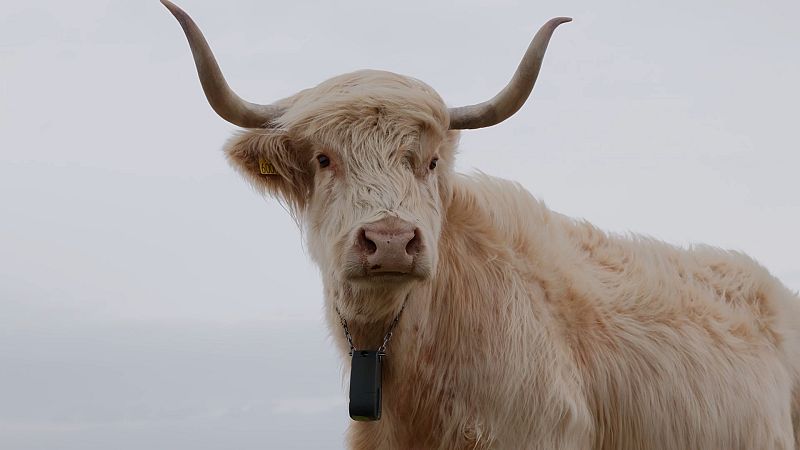Sweden and Denmark will soon legalise virtual fencing. What is it and is it safe?

Across Europe, livestock graze across vast pastures often bordered by miles of wire and the occasional jolt of electric current.
But what if those fences were no longer there?
The idea of virtual fencing, which replaces physical barriers with digital ones, has gained momentum globally in recent years.
In Norway, a start-up named Nofence developed GPS-enabled collars to create digital boundaries that keep animals exactly where farmers want them without a single strand of wire, and to change these invisible borders in just seconds.
When an animal approaches the virtual border, the collar emits a gentle audio cue, followed by a mild pulse if the warning is ignored. Over time, livestock learn to recognise and respect the sound, staying safely within their designated area, the company says.
The solar-powered collars are controlled remotely through a mobile app, allowing farmers to define pastures and move boundaries on their phone.
This flexibility saves farmers significant time and labour otherwise spent mending fences, while also reducing reliance on supplementary feed, according to Nofence.
The invisible fences can also be set up in areas where it is” impossible to put up physical fences, such as wetlands, rocky terrains or in…very dense vegetation,” according to Lotten Valund, a researcher at RISE Research Institutes of Sweden, who has been studying the use and impact of virtual fencing since 2019.
“Virtual fencing makes it possible to graze more land than before and also use areas that are not what you say could be used for crop production for human consumption. So we can use other types of land for producing meat on,” Valund told Euronews Next.
Is it safe for the animals?
Nofence says its goal is to help farmers “make better management decisions”.
“In the longer term, we're collecting a lot of data with our product. So with this data, we will enable farmers to make better decisions and optimise how they manage their animals further,” Lars Kvaalen, Nofence’s CFO, told Euornews Next.
When it comes to animal welfare, Nofence says virtual fencing is a better solution for animals as the electric pulses it uses are “much gentler” than electric fencing, which is “already an established practice globally”.
Nofence says animals typically learn to respond to the audio cue within a few days, where they are trained with a physical fence within which virtual boundaries are set.
Over time, as much as 96 per cent of the boundary interactions for the livestock happen through the audio cue without the need for an electric pulse, thanks to this training programme, Nofence said.
In a 2022 study, Valund looked into the stress levels of animals when using virtual fencing.
While there’s “very limited data” on how animals react to traditional electric fences, the Swedish study found no evidence of increased cortisol levels in animals from virtual fencing compared to physical fences.
“The current result doesn't show any difference from traditional electric fences, looking into the behaviour of animals and also looking into the stress levels of the animal; the cortisol level, which is a stress hormone,” Valund said.
Still, she believes further research is needed to safeguard welfare standards.
“I think it's very important for the future to have a really clear definition of what type of function the virtual fence should include…to have a high level of animal welfare,” said Valund.
“Because it should be easy for the animal to do the right behaviour, and if the system is built in certain ways, it could be bad for the animals. They need to have [enough] time to turn around [up]on the audio cue, for example,” she added.
Where can it be used?
While Nofence hopes to make virtual fencing the standard across, virtual fencing researchers believe the technology is not a replacement for the wires due to network reliability and battery life.
“I don't see this system as something that should be used as the only alternative for grazing management,” Valund said.
“For example, the collars depend on batteries, the GPS signals, and the mobile connectivity. So this can sometimes cause interruption, especially in remote areas and so on”.
“For some farmers, it will work very well and they will use it fully. For others, it may serve as a complement to their system they have now, so one approach should not exclude another,” Valund added.
More than 7,000 farms are using Nofence’s collars, with most clients in Norway. The company says the tech is expanding to reach the United States and Canada.
While many European countries still prohibit virtual fencing, several, including Spain, the Netherlands, Norway, Ireland, and the United Kingdom, have approved its use.
In 2018, Sweden’s Board of Agriculture banned virtual fencing due to concerns about long-term animal welfare impacts. However, last week Sweden, announced it would legalise virtual fencing for cattle and sheep from next year, while Denmark will follow suit for cattle.
“Now we are going as not the first country but one of the first to legalise this technology. So I think that there will be discussions between the countries and they will talk to Sweden [about] their thoughts about this process”.
For more on this story, watch the video in the media player above.
Today

